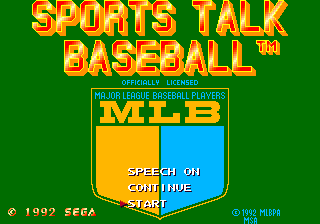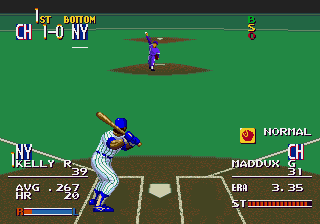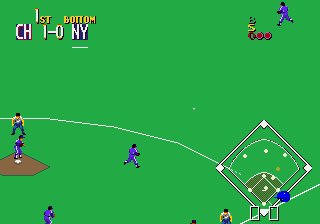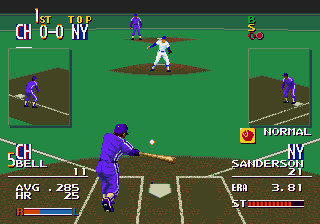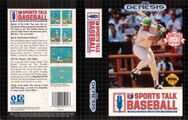Difference between revisions of "Sports Talk Baseball"
From Sega Retro
MarioSnicU (talk | contribs) |
IgoreshaZhu (talk | contribs) |
||
| (One intermediate revision by one other user not shown) | |||
| Line 1: | Line 1: | ||
{{Bob | {{Bob | ||
| bobscreen=SportsTalkBaseball_MDTitleScreen.png | | bobscreen=SportsTalkBaseball_MDTitleScreen.png | ||
| − | | publisher=[[Sega]] | + | | publisher=[[Sega of America]] |
| developer=[[Sega CS2]] | | developer=[[Sega CS2]] | ||
| support={{company|[[Western Technologies]]|role=sounds}} | | support={{company|[[Western Technologies]]|role=sounds}} | ||
| licensor=[[Major League Baseball Players Association]] | | licensor=[[Major League Baseball Players Association]] | ||
| system=[[Sega Mega Drive]] | | system=[[Sega Mega Drive]] | ||
| − | | sounddriver=[[ | + | | sounddriver=[[Sega Music Development System]] |
| peripherals= | | peripherals= | ||
| players=1-5 | | players=1-5 | ||
Latest revision as of 06:26, 28 October 2024
| Sports Talk Baseball | ||||||||||
|---|---|---|---|---|---|---|---|---|---|---|
| System(s): Sega Mega Drive | ||||||||||
| Publisher: Sega of America | ||||||||||
| Developer: Sega CS2 | ||||||||||
| Supporting companies: Western Technologies (sounds) | ||||||||||
| Licensor: Major League Baseball Players Association | ||||||||||
| Sound driver: Sega Music Development System | ||||||||||
| Genre: Sports (baseball) | ||||||||||
| Number of players: 1-5 | ||||||||||
|
Sports Talk Baseball is a 1992 baseball game by Sega for the Sega Mega Drive released exclusively in the US. It takes Pro Yakyuu Super League '91 and replaces the music with a running commentary in the style of Joe Montana II Sports Talk Football (done by various Western Technologies employees).
Sports Talk Baseball is licensed by the Major League Baseball Players Association, so it includes real players. It does not, however, have a full Major League Baseball license, so teams are referred to solely by their cities or states.
Contents
Gameplay
The game follows the rules of MLB baseball. Players can choose from any of the 26 teams, with rosters accurate for the 1991 MLB season. Unlike real professional baseball, there is a "mercy" rule that ends the game when one team is leading by 10 or more runs.
Before each game, each team can choose a starting pitcher, order the batting line-up, change each player's position, and substitute players. Players can choose from three venues: the White Sky Dome (standard-sized field in a dome), the Blue Moon Stadium (largest field, nighttime game), or the Red Sun Stadium (smallest field, daytime game). In single-player games, the player can additionally choose whether to bat or field first, to disable auto-fielding (where the computer automatically positions outfielders), and to make changes to the computer player's roster.
Modes
There are three modes:
- Pennant Race: A single-player mode where the player plays a season of 15, 30, 81, or a full 162 games.
- Exhibition Game: A single match against the computer or a five-game series against another player. Up to five players can participate in a round robin tournament format.
- All Pro Game: A single match against the computer or another player, pitting the American League All Pro Team against the National League All Pro Team (similar to the Major League Baseball All-Star Game). Players can substitute players from any team in either league to create a custom team.
Teams
| League | Division | Team | Based on |
|---|---|---|---|
| American | Western | California | California Angels |
| Kansas City | Kansas City Royals | ||
| Chicago | Chicago White Sox | ||
| Seattle | Seattle Mariners | ||
| Oakland | Oakland Athletics | ||
| Texas | Texas Rangers | ||
| Minnesota | Minnesota Twins | ||
| Eastern | Baltimore | Baltimore Orioles | |
| Cleveland | Cleveland Indians | ||
| Boston | Boston Red Sox | ||
| New York | New York Yankees | ||
| Milwaukee | Milwaukee Brewers | ||
| Toronto | Toronto Blue Jays | ||
| Detroit | Detroit Tigers | ||
| National | Western | Atlanta | Atlanta Braves |
| San Diego | San Diego Padres | ||
| Los Angeles | Los Angeles Dodgers | ||
| Houston | Houston Astros | ||
| Cincinnati | Cincinnati Reds | ||
| San Francisco | San Francisco Giants | ||
| Eastern | Chicago | Chicago Cubs | |
| Pittsburgh | Pittsburgh Pirates | ||
| Philadelphia | Philadelphia Phillies | ||
| New York | New York Mets | ||
| Montreal | Montreal Expos | ||
| St. Louis | St. Louis Cardinals |
Production credits
- Main Programmer: Mizoran
- Assistant Programmer: 武
- Graphic Designer: Sadachan, Vaon, 7LY Big King, Thomas ♥ Yuuda, Rice
- Game Designer: Vanta
- Voice and Sound by: Western Technologies
- Allen Maynard
- Jeff Fort
- Ray Frericks
- E.S.S.
- Translations by: Takeshi Sumida, James Gros
- Special Thanks: Ohsan, The Fort, Silver Chariots, Mudamudamudamudamuda, Kongotomo Yoroshiku, Sushi-X Modoki, Dio Sama, Team Clutch Hitter, Pochi
- © 1992 MLBPA
- © 1992 SEGA
- Presented by: Sega
Magazine articles
- Main article: Sports Talk Baseball/Magazine articles.
Promotional material
Physical scans
| Sega Retro Average | ||||||||||||||||||||||||||||||||||||||||||||||||||||||
|---|---|---|---|---|---|---|---|---|---|---|---|---|---|---|---|---|---|---|---|---|---|---|---|---|---|---|---|---|---|---|---|---|---|---|---|---|---|---|---|---|---|---|---|---|---|---|---|---|---|---|---|---|---|---|
|
| 76 | |
|---|---|
| Based on 10 reviews | |
Technical information
- Main article: Sports Talk Baseball/Technical information.
References
- ↑ Sega Visions, "May/June 1992" (US; 1992-xx-xx), page 58
- ↑ 2.0 2.1 GamePro, "June 1992" (US; 1992-xx-xx), page 46
- ↑ 1700 igr dlya Sega, "" (RU; 2001-xx-xx), page 287
- ↑ Game Power, "Luigio/Agosto 1992" (IT; 1992-0x-xx), page 56
- ↑ Mega, "October 1992" (UK; 1992-09-17), page 54
- ↑ Mega Action, "June 1993" (UK; 1993-05-20), page 64
- ↑ Sega Pro, "October 1992" (UK; 1992-09-10), page 38
- ↑ Sega Pro, "April 1993" (UK; 1993-03-11), page 67
- ↑ Supergame, "Outubro 1992" (BR; 1992-10-xx), page 24
- ↑ Tricks 16 bit, "Tricks Sega Gold 800 igr" (RU; 1998-03-20), page 171
- ↑ Zero, "August 1992" (UK; 1992-07-xx), page 27
| Sports Talk Baseball | |
|---|---|
|
Main page | Magazine articles | Reception | Region coding | Technical information | Bootlegs | |
| Games in the Super League series | |
|---|---|
| Super League (System 16) (1987) | Super League (Mega Drive) (1989) | Clutch Hitter (1991) | Pro Yakyuu Super League '91 (1991) | Sports Talk Baseball (1992) | Pro Yakyuu Super League CD (1992) | Egawa Suguru no Super League CD (1993) | |
